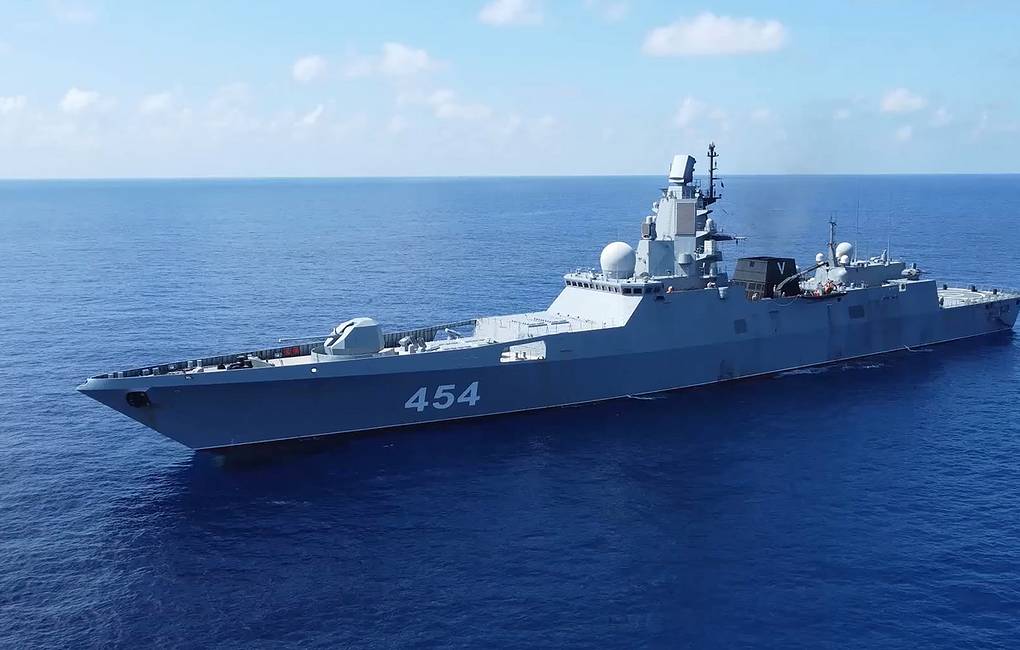Look Who Steamed Into Port - The Adm Gorshkov

This is no ordinary warship; it is the pride of the Russian Navy. Admiral Gorshkov is the model upon which Russia will project its 21st-century sea-going fighting force.
The ship carries 210 sailors, is 443 feet long, and has 48 cells from which to fire some of the most advanced missiles in the world, including the Kalbir and hypersonic Zircon. Those missiles were sent to deliver a message to Washington. The question is whether this Administration will get the point.
The Adm Gorshkov is Russia's most advanced battleship, labeled a Frigate. This designation has a heritage that goes back to the 15th century when the Spanish and Portuguese Navies developed a fast, maneuverable warship capable of striking land or sea enemies. By the 1950s, the US Navy adopted this designation for a new class of ships designed to carry various missile launchers called guided missile frigates.
While the Guided Missile Frigate remains an important component of the US Navy, the Aircraft Carriers (designated CVN) are its premier battleships. As we've seen recently, when America wishes to project power, it is with the CVN-designated Carriers. When the Houthis attacked shipping in the Red Sea, it was the Carrier Eisenhower's Task Force that enforced Operation Prosperity Guardian.
In the same sense, the Russians have now sailed their flag battleship into Havana Harbor. This is much more than a mere casual port call; it is a direct warning to the Caribbean and Southern US that Russia is on watch.
Of course, for those of us who are old enough to remember, the actions this week are eerily similar to the time in 1962 when President Kennedy faced off against the Soviet Union. At the time, the Soviets attempted to place ICBM missiles in Cuba, missiles that were capable of carrying nuclear weapons.
Through careful negotiations, Kennedy was able to diffuse this critical challenge by first blockading Soviet Ships from reaching Cuba, and bargaining to withdraw US Nuclear Missiles from Turkey, thereby lessening the threat to the Soviet homeland.
This latter point is crucial and something that Americans learned of years later. Kennedy recognized that the Soviet motivation was to reduce the American threat aimed at them.
Writing in Foreign Policy Magazine, William Burr puts it this way:
The Cuban missile crisis was resolved when President Kennedy secretly agreed to remove Jupiter intermediate-range ballistic missiles from Turkey, along with a pledge not to invade Cuba. In contrast, Soviet Premier Khrushchev agreed to remove the missiles from Cuba.
https://foreignpolicy.com/2012/10/26/still-secret-after-all-these-years/
Diplomacy had saved the day and preserved the world when it came the closest to a direct nuclear confrontation.
Today, the Russian Federation has just parked more firepower at a dock in Havana than the old Soviet Union could have dreamed of. What exactly does Adm Gorshkov have in those 48 cells under its massive deck? We do not know. But we do know that 16 of those cells could hold the technologically advanced Zircon missile, a missile capable of employing a nuclear warhead and achieving hypersonic speed.
But even a conventionally armed Zircon, with today's modern munitions, is capable of wiping out an American city. And while there is much debate about the Zircon's range, there's no doubt that Miami, Tampa, and Atlanta are all vulnerable.
Unfortunately, the Russian threat to the US mainland may not end with Adm. Gorshkov's departure. Scott Ritter, the retired US Marine Captain and former UN Weapons Inspector, speculated that the Russians may "leave something behind." By this, he means that Gorshkov may deliver missiles to Cuba, missiles that would remain in Cuba.
Last week, speaking to a group of reporters at the St. Petersburg Economic Forum, President Vladimir Putin stated that he could deploy missiles within striking distance of Europe or America. Or that he could give missiles to other countries, which Russia could use to strike the EU or USA.
In his usual measured way, Putin puts it this way:
"If we see that these countries [by which he means the US and Europe] are being drawn into a war against the Russian Federation, then we reserve the right to act similarly. In general, this is a path to very serious problems." Vladimir Putin June 5, 2024
https://www.reuters.com/world/europe/putin-says-west-is-wrong-assume-russia-would-never-use-nuclear-weapons-2024-06-05/
And just like that, it's 1962 all over again: Russia (formerly the Soviet Union) versus the United States in a nuclear standoff that could impact the entire world. Back then, America had placed missiles on the doorstep of the USSR.
Today, America has permitted Ukraine to fire missiles directly into Russian territory. Russia counters by placing missiles close to the American heartland.
In 1962, an American President used diplomacy to see things from the Soviet perspective. Continuous dialog between the two belligerents led first to a mutual understanding of each other's requirements and then to an agreed-upon settlement. Without Kennedy's recognition that American missiles in Turkey were a direct threat to the Soviets, this dispute may have ended in a Nuclear War.
Today, a somnolent President barely makes it through his speeches. One wonders if he has the capacity to see things from another's perspective, as Kennedy did so many years before. There can be little doubt that President Biden has crossed a Russian Red Line. Permitting Ukraine to fire American long-range missiles into Russia has taken the Ukraine conflict to the next level. It is an incredibly provocative move.
A move that Putin just countered. The question becomes: will Biden consider Jacksonville a fair trade for Belgorod?